AMD Teases Radeon RX 480: Launching June 29th For $199
by Ryan Smith on May 31, 2016 10:00 PM EST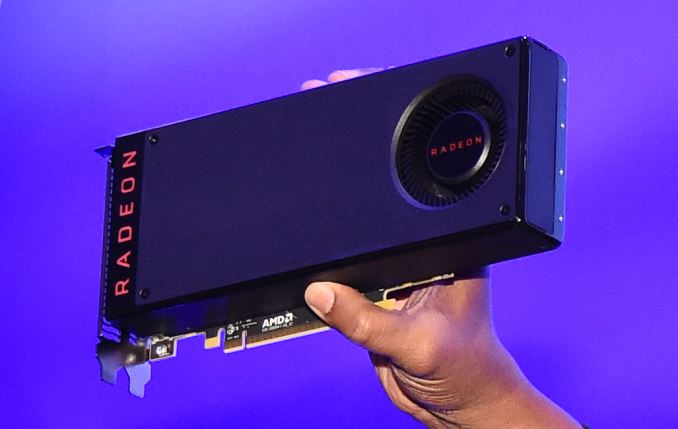
Kicking off at this moment is AMD’s Computex 2016 keynote. The company has multiple announcements scheduled this evening, but we’re going to jump right into an area that has been of extreme interest for many of our readers: GPUs.
Ahead of this evening’s event, AMD sent out an email to the press teasing the first of their discrete Polaris architecture based cards. Called the Radeon RX 480, AMD has unveiled much of the product’s specifications, but also its price and availability. When the card hits the streets on June 29th, it will be starting at the crucial mainstream battleground price point of $199.
| AMD Radeon GPU Specification Comparison | ||||||
| AMD Radeon RX 480 | AMD Radeon R9 390X | AMD Radeon R9 390 | AMD Radeon R9 380 | |||
| Stream Processors | 2304 (36 CUs) |
2816 (44 CUs) |
2560 (40 CUs) |
1792 (28 CUs) |
||
| Texture Units | (Many) | 176 | 160 | 112 | ||
| ROPs | (A Positive Integer) | 64 | 64 | 32 | ||
| TFLOPs (FMA) | >5 TFLOPs | 5.9 TFLOPs | 5.1 TFLOPs | 3.5 TFLOPs | ||
| Boost Clock | >1.08GHz | 1050MHz | 1000MHz | 970MHz | ||
| Memory Clock | 8Gbps GDDR5 | 5Gbps GDDR5 | 5Gbps GDDR5 | 5.5Gbps GDDR5 | ||
| Memory Bus Width | 256-bit | 512-bit | 512-bit | 256-bit | ||
| VRAM | 4GB/8GB | 8GB | 8GB | 2GB | ||
| Transistor Count | ? | 6.2B | 6.2B | 5.0B | ||
| Typical Board Power | 150W | 275W | 275W | 190W | ||
| Manufacturing Process | GloFo 14nm FinFET | TSMC 28nm | TSMC 28nm | TSMC 28nm | ||
| Architecture | GCN 4 | GCN 1.1 | GCN 1.1 | GCN 1.2 | ||
| GPU | Polaris 10? | Hawaii | Hawaii | Tonga | ||
| Launch Date | 06/29/16 | 06/18/15 | 06/18/15 | 06/18/15 | ||
| Launch Price | $199 | $429 | $329 | $199 | ||
First off, the RX 480 will include 36 CUs. If we assume 64 stream processors to a CU – the GCN standard – then this brings us to 2304 SPs. AMD has not named the specific Polaris GPU being used here, but given the CU count I believe it’s reasonable to assume that this is a Polaris 10 SKU, as I’ve already seen Polaris 11 and it’s a very small chip better suited for notebooks.
AMD also revealed that the card would offer over 5 TFLOPs of compute performance. Given what we know about the CU count, this allows us to estimate the GPU clockspeed. This puts the lower bound of the GPU clockspeed at 1.08GHz and an upper bound (6 TFLOPs) at 1.3GHz, which would be in the range of 10-30% higher clocked than comparable Radeon 300 series cards.
In terms of raw numbers this puts the RX 480 just shy of the current Radeon R9 390. However it also doesn’t take into account the fact that one of the major focuses for Polaris will be in improving architectural efficiency. I would certainly expect that even at the lower end of clockspeed estimates, RX 480 could pull ahead of the R9 390, in which case we’re looking at a part that would deliver performance between the R9 390 and R9 390X, with final clockspeeds and architectural efficiency settling just how close to R9 390X the new card gets.
On the memory front the card is equipped with 8Gbps GDDR5, running along a 256-bit memory bus. This is the typical bus width for AMD x80-series cards, and the high clocked 8Gbps GDDR5 means that we’re looking at a total of 256GB/sec of memory bandwidth to feed the RX 480’s GPU. AMD’s partners will be offering both 4GB and 8GB cards, and for the purposes of this teaser I assume that pricing information will be for the 4GB card, with 8GB serving as a premium option.
Finally, AMD has also revealed the TDP for the RX 480, stating that it will be a 150W card. As Polaris is built on 14nm FinFET, we’re seeing first-hand the benefits of finally making the long-awaited jump off of 28nm, as this means we’re looking at Radeon R9 390 series performance in a card that, on paper, consumes only a bit more than half the power. This also puts the RX 480 right in the sweet spot for mainstream cards, as 150W has traditionally struck a good balance between performance and power consumption that allows for a fast card that doesn’t require aggressive cooling, and is more compatible with OEM computer vendor case & cooling designs.
Cementing its place as a mainstream card, the RX 480 pricing will start at $199. This is an aggressive and heavily fought over price point that has traditionally defined the mainstream segment, attracting buyers who want great 1080p gaming performance that sub-$150 value cards can’t offer, without moving up to more expensive (and power hungry) $300+ cards. In this sense the RX 480 is a direct replacement for the R9 380, AMD’s Tonga-based card that hit the market roughly a year ago at the same price. Going by the raw numbers alone, RX 480 would be 40% (or more) faster than the R9 380.
Meanwhile I won’t speculate too much on the competitive market from a teaser, but it’s worth noting that this is nearly half the price of NVIDIA’s currently cheapest Pascal card, the GeForce GTX 1070. Interestingly both cards have the same 150W TDP, but looking at the throughput figures it does not look like RX 480 is meant to offer quite as high performance as NVIDIA’s card.
Moving on, along with teasing the RX 480’s specifications, AMD’s teaser also laid out their marketing plans for the card. We’re previously talked about how both Oculus and Valve/HTC were encouraging developers to treat VR like a fixed platform, and setting minimum hardware specifications to go along with that. On the AMD side those specifications called for a Radeon R9 290, which the RX 480 should be able to beat.
As a result AMD is planning on heavily promoting the VR aspects of the RX 480, as it brings the necessary performance down from a 250W, $300+ card to a 150W, $200 card. In fact AMD is claiming that VR performance will be closer to $500 video cards, in which case we’d be looking at performance closer to the Radeon R9 Nano, a Fiji based card.
With all of that said, the video card is just one component in the total price of a VR system – you still need the headset – but on the PC side it has also been the most expensive component. Consequently, AMD sees cheaper video cards that offer good VR performance as being important to bringing down the total price of a VR-ready system, and will be promoting the RX 480 as the prescription for entry-level VR needs. From a business perspective, AMD is ultimately expecting VR to be a fast-growing market, so the company wants to make sure they don’t miss out and have more VR-capable cards on the market as quickly as they can.
Along those lines, AMD’s release also makes note that at least one model will be “both HTC Vive Ready and Oculus Rift certified,” though no further details are being offered at this time. Whether this is just a certification matter or if there’s going to be something special about this model (e.g. connectors) is open to speculation.
Finally, now that they’ve revealed the price and much of the specifications of their first Polaris card, AMD is also releasing more details on their overall development and market positioning strategy with Polaris. As AMD has hinted at in the past, Polaris is being specifically developed for and aimed at the mainstream market. AMD wants to recapture lost market share – especially in laptops – and the large mainstream market is seen as the best way to do that. AMD is calling this their “water drop” strategy, and I expect we’ll hear a bit more about it tonight, including the meaning behind the name.
And with all of that said, it looks like we’re going to have a lot of AMD to talk about on June 29th. So until they, stay tuned.
Above: AMD SVP & Chief Architect Raja Koduri, Who Is Very Happy That Polaris Is About To Launch


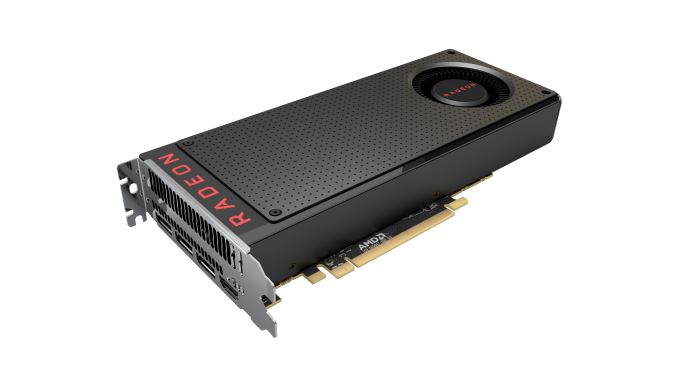

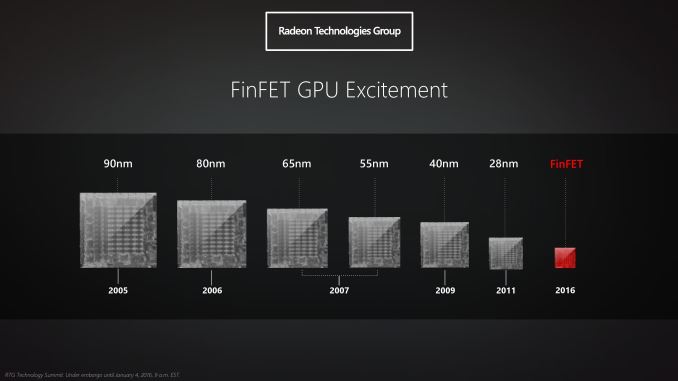
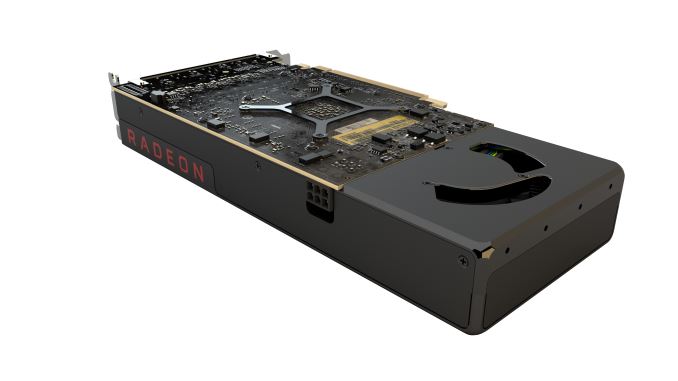




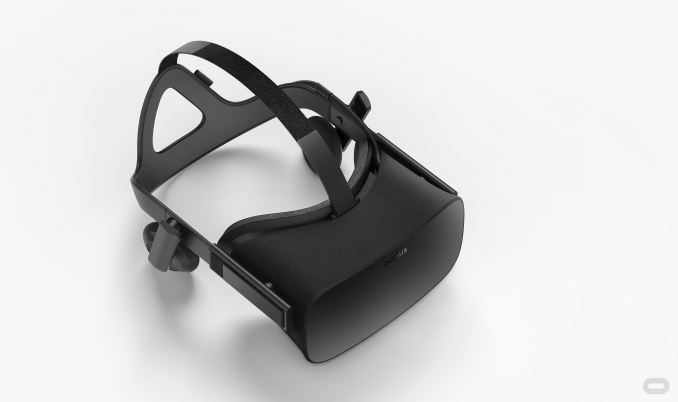









377 Comments
View All Comments
Narg - Wednesday, June 1, 2016 - link
G-Sync is a poor reason. Just lock your frame rates. Moving frame rates are just as bad a sync issues. Smooth game play comes from a steady frame rate. And since the human eyes can detect more than 30 FPS, I'm still at odds as to why people bother. More is not always better, or useful at all.blppt - Wednesday, June 1, 2016 - link
Because tearing can still happen at lower than fixed framerates too. If it were as simple as locking my games to 60fps without vsync, I wouldnt even consider buying a gsync/freesync monitor. And tearing bugs the hell out of me---what's the point of getting a card able to play the latest high-end graphics when those wonderful graphics are tearing?HideOut - Wednesday, June 1, 2016 - link
again, why do we have to log in now for every post...But human eyes can see 50-60fps if you have normal vision. Some people with extremely sensitive yes can get closer to 70. 30 is laggy as hell in action sequences.
Morawka - Wednesday, June 1, 2016 - link
nonsense. human eyes can recognize the fluidity difference all the way up to 175 FPS. Just pull out your iphone and put it in video mode and select 120 or 240 FPS capture and notice how much fluid the movements are.willis936 - Sunday, June 5, 2016 - link
Well phone displays are only running at 60 fps so I'm not quite sure what looking at it would tell you.bcronce - Thursday, June 2, 2016 - link
Humans don't see in "FPS", but we tend to normalize to FPS which has some issues since we perceive different different aspects of FPS.Human vision has a minimum of around 24 FPS to see "motion" before we start to see a slide show of rapidly succeeding images. Humans process images at a rate of about 30 updates per second. It can take up to 100ms to integrate an image into consciousness. While 10ms is considered instant for delay purposes, the brain can detect timing anomalies close to 1ms. We can visually recognize unexpected differences in images as fast as 300fps.
The best way to describe human vision in a nutshell is we process about 30fps, but we continuously integrate and can detect visual anomalies at a rate of around 300fps.
I have myself been able to reliably tell the difference between 70fps and 85fps in my hayday of Counter-Strike, and I was able to eventually notice after several seconds if someone was using a 120hz screen because of the higher real FPS. Fast paced motions were noticeably smoother and easier to predict instead of the strobe-effect slide-show of 85hz. In both situations the rendering FPS was about 150-200, but the refresh was either 85hz or 120hz, and it was noticeable.
HollyDOL - Monday, June 6, 2016 - link
I suggest reading some scientific facts about this human eye fps issue. For one I recommend Michael Duggan's "The Official Guide to 3D Game Studio", the most interesting part here: https://books.google.cz/books?id=weMLAAAAQBAJ&...G0053 - Thursday, June 2, 2016 - link
I am by no means a competitive gamer, but I can perceive the drop from 120 to 100 fps on my 144hz monitor in games a simple as Heroes of the Storm. Even my wife notices a reduction in smoothness of game play in Borderlands when dropping from 72 to sub 60fps.scewb - Thursday, June 2, 2016 - link
The human eye can physiologically detect up to 1000 frames per second. 60 is acceptable in slow games but i want 150+ in competitive FPS.vango - Thursday, June 2, 2016 - link
Your stupid.. your eyes can see past 30 frames easy.. I can sure tell by any weak game on a console in comparison .. I also have issues with some games dipping below 60 down to 30 when I play games and noticed the slow down so yeah it is a big deal having plenty of frames when action picks up in a game because they drop.. So you really don't know what your talking about. Your eyes don't work like that MR Doc Narg.. By the way it's clear to see the difference in 4k video but guess what the average is 72 frames during video. Just stick to your console where you belong..